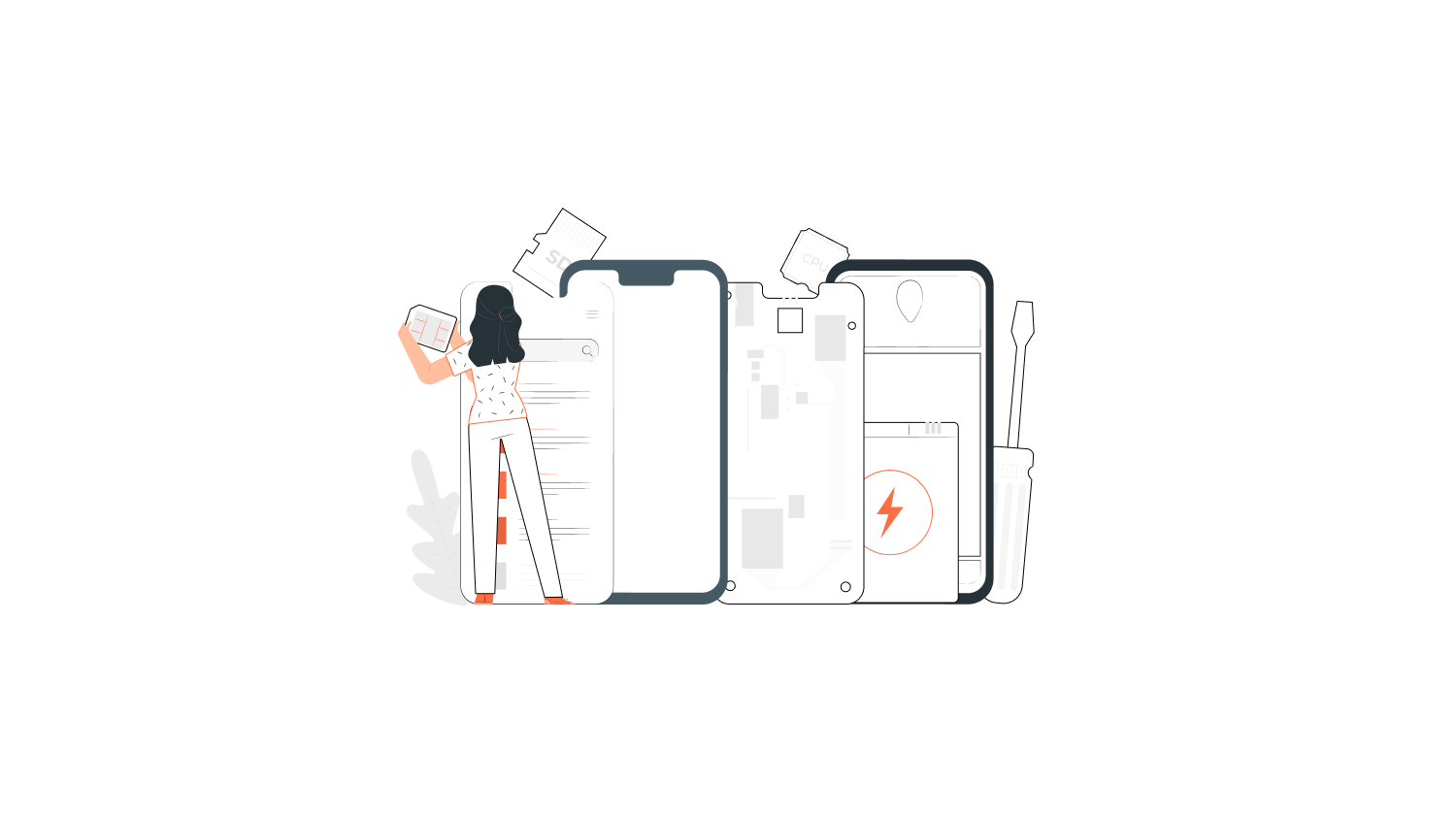Research from Statista shows education as the second most popular category on Android, which could surprise you if you’ve never heard of it. It makes up 9.31% of the total number of applications in circulation.
Now is the appropriate time to launch your educational software. See this comprehensive educational app development guide to learn how to build an educational app.
Starting with the latest trends and advantages, this blog teaches you all you need to know about developing an education app from scratch – from identifying critical considerations (and ones to avoid) during the early stages of the project planning process to deployment and more.
Growth in the market for online education as a whole
E-learning is one of the fastest-growing industries. The 1960s was the era of computers, and Macintosh computers allowed them to be delivered to people’s front doors. Only 8% of individuals were utilising it in the early days, even though schools and corporations began to use it.
However, by 2008, the percentage had risen to 20%. Since 2004, the number of students registered in courses online and educational startups has increased by 263%, according to elearninginfographics.com.
Graphics show how game-changing innovations are altering schooling in the modern world.
Digitisation is the driving force behind all of these trends.
E-learning is predicted to be valued at 1 trillion USD worldwide by 2028, based on a study done by our team. This is a more than threefold increase from $107 billion in 2015.
Where is the sweet spot, and what is unique about online education? What justifies the development of a mobile learning app for the iPhone or Android platform? That is what we are going to explore throughout this article.
Types of educational apps
Let’s look at all the available options before deciding what kind of learning app you want to build. It might inspire you to come up with new ideas.
Three possible users for implementing educational solutions are:
- Students
- Their legal guardians or parents
- Teachers
You may also consider school administration or advertising companies as additional possible users (interested in placing ads on your education platform). Managing the provision of digital products will almost certainly necessitate an extra layer of management.
Beyond there, you’re in the middle of the American West. For example, G2’s list of educational software subcategories includes:
- e-learning platforms (LMS)
- management software for teaching and learning
- ERP systems for the education sector
This is where we’ll begin our study of the best educational applications.
How to develop an education app in 6 easy steps
Indeed, now that you’ve seen how unique educational applications can be, you’d like to get involved in this booming industry? From creating the most effective academic content to creating an app that will go viral and excite young minds, creating an educational app is no easy task. Realising that educational applications strike the perfect harmony between vision and aesthetics is critical.
In addition to your ideas, we’ll go through a few stages to help you map out the ideal plan for creating an educational app.
Step 1: Discovery
Developing mobile learning apps is no exception; in our experience, every successful project begins with a discovery phase. The discovery process involves figuring out your target audience and what they’re looking for.
Choosing a platform for your mobile solution depends on who it will use and for what purpose. Your chosen platform will influence the tools and frameworks your development team uses. Would an online desktop experience be preferable for your target audience, or are they more comfortable with tablets and smartphones?
Your AI bot may be able to extract free exams from the internet that match your talents if you’re constructing an app for self-training. Assuming your app is intended for a broad audience, using a cross-platform development framework like React Native or Flutter is an obvious choice. You’ll be able to simultaneously release the applications for iOS and Android, which will save you money.
The educational app should be built as a web solution if your intended audience is instructors, and the answer will assist them in putting together assignments and learning materials.
Step 2: Research your users and your competition
There are already hundreds of educational applications on the market. Do you have any ideas for improvement? If you’re a kid’s parent or app creator, let me tell you: There may be a hundred educational applications on the market, but there’s a lot of room for improvement.
As the second step, gather feedback from a wide range of users, including your family, friends, coworkers, and neighbours. Make time to sit down with your students and find out what they desire and struggle with—people’s wishes and what they enjoy about the current offerings.
After that, take a close look at your rivals. Additionally, you may accomplish this by seeing how other people use your rivals’ applications and spending enough time using those competitors’ apps. Consider how you can improve the experience by analysing strengths and flaws, identifying gaps, and brainstorming ideas.
Step 3: Validate by rapid prototyping
It’s time to formalise your concept once you’ve determined for whom you’ll be developing. This is accomplished by the creation of an interactive prototype with a UX/UI design that closely resembles that of a simple app.
Initially, the goal is to get feedback from the intended audience and make adjustments depending on that feedback. Consequently, you’ll be ready for the following phase, when you’ll need to turn your prototype into code.
However, what should we be aware of before creating an educational app?
- Remember that kids like to tinker with things, so ask for one thing and observe how they do the other thing that is truly important to you as you build user tests to evaluate the viability of the UX.
- To compensate for the slower internet connections at some educational institutions, use the best picture and video formats, caching, and other similar measures.
- A wide range of people should be able to use it.
- Do not forget to test your application from the perspective of both the student and the educator.
Step 4: Develop a creative differentiator
Make sure you have something that sets you apart from the competitors. An innovative idea, a user-friendly feature, or something that appeals to a particular group of people will set you apart from the competition.
If you’ve struggled with arithmetic, you’ll be glad to know that apps like PhotoMath and Mathway may help you. Your phone becomes a creative whiteboard with Doceri.
There are more than 70 languages supported by Remind’s message and note translation service. Through interactive games and quizzes, Kahoot transforms classrooms from drab to fabulous.
To make learning entertaining on your app, you can must onboard your creative differentiator while developing your idea.
Also Read: Top Educational App Ideas and Features That Startups Should Check Out In 2022
Step 5: Determine the app development platform
Have you made up your mind on whether you’ll build your app for iOS or Android? Another option is to create an app that can operate on different platforms, known as cross-platform development.
Your app’s success depends on the platform on which it runs, and this is especially true in the online education market. Google’s Android is currently the most popular mobile platform, with over 2 billion active users.
Moreover, half of the American market chose iOS as their smartphone’s operating system, even though Android has more users than any other platform. Your educational software might benefit from being developed for iOS and Android devices. Then there’s the possibility of creating a cross-platform mobile app.
Before deciding on an app development platform, here are a few things to keep in mind:
- Which country is your target audience?
- An application’s development time
- Complexity of creation
If you’re still unsure, consider working with a mobile app development company. They can assist you in determining which platform is suitable for your app and create it from the ground up to your specifications.
Step 6: Engage the services of an app development company
After settling on all the crucial considerations, choosing an educational app development company is the final step. This is unquestionably a critical step in the creation of an app.
Choosing an amateur developer or a business with no prior expertise in building mobile educational applications would be a massive mistake if you were an entrepreneur. Clutch, Upwork, and Toptal are good places to locate a team of competent developers.
Depending on your company’s needs, you should look at their websites or portfolios and entire work experience before you hire developers or firms.
4 Stages of Building an Education App
It’s critical to have a thorough grasp of the many steps involved in eLearning application development before you win and get started.
Your end users’ demands may be met if you have an understanding of the concept and each stage in the development process.
You can see below how the steps for creating an eLearning app are laid out:
1. Analyze and ideate
A solid concept and idea are the building blocks of a successful eLearning app. Until then, it will not be able to grow into a highly sought-after instructional tool. Think about the topics you’ll cover and the format you’ll use to reach different types of students.
After your research, have a few brainstorming sessions to help you move on to the next app development step. Additionally, obtaining essential suggestions and insights can help you stand out from your rivals.
Remember that the app will only be helpful if the idea behind it is sound. So you must conduct extensive research on the target demographic to determine the app’s usability and profitability. If the test is successful, you may go on to the next step, creating a timetable for the app’s creation.
Look at the 15 App Ideas for Students and Startups to Launch in 2022
2. App design
eLearning applications’ user-friendliness and experience are two critical reasons for their growing popularity among students and parents alike. Use interactive and engaging touchpoints in the creation of your e-learning software.
Your ultimate objective should be to make your users as comfortable as possible so they will return to your site repeatedly. The goal is to keep the user engaged long enough to keep them returning for more material.
Don’t forget to pay attention to the small details like typefaces and colours. Be careful not to overcrowd the design with these features.
3. App development
The conceptual phase begins immediately. As a result, the app’s idea and the features you’ve decided to put in it will be better validated.
Iterative development and testing are critical components of this stage. Testing, problem patches, and new features and functions must be added to the programme before it can be released.
4. Deployment
The process in which you deploy your application might be just as crucial to its overall success as any of the procedures that came before it. To get your app off the ground, you need to have a significant effect as soon as possible.
This is because most applications see a surge in the number of downloads shortly after they are released, followed by a slow decline in the number of sales.
Determine when the launch will take place, and then start making announcements about it on the social media accounts associated with your business well in advance. No hard and fast rule dictates how prolonged a product validation should be.
Still, you want to find a happy medium between having a marketing campaign that is too short and does not generate enough interest and having a marketing campaign that is too long and causes the public to lose touch with you.
How do you monetize educational apps & make money?
Knowing whether or not to monetize your educational mobile app is an essential step in the development process. The truth is that most of these applications need a subscription fee. It’s still possible to develop commercialised instructional software, but there are a few things to keep in mind.
One of the most common ways to monetize an app is by charging a monthly subscription fee. You may choose to charge a monthly or yearly membership fee for the usage of your educational software.
For a short time, you can also make all of your material available as a free trial. Most software that uses this idea considers two weeks to be a reasonable amount of time.
Access is revoked after that specific time, and you’ll have to pay to regain it. This approach best serves service-oriented initiatives, which provide recurring income for companies.
Users can only access some features of freemium educational software if they sign up for an additional fee. This business model for mobile apps aids in the rapid growth of a significant user base. In addition, it reveals your software to users, making them more likely to pay for premium features later on.
An excellent example of this is Adobe Stock. You may get ten free stock pictures if you purchase a regular or extended licence.
Using data-driven advertising in your educational mobile application development is a way for you to make money online. You may go it alone or work with a mobile advertising partner.
This might backfire, as adverts irritate and dissatisfy users. Limit the adverts in your app and only use those relevant to your app’s content to avoid this. YouTube Kids is used primarily for instructional purposes.
However, it does contain sponsored content from time to time. For a fee: This is a “pay before you play” setup. Payment is made in advance, even before the file is downloaded. The developer receives a fee before the purchase price when a user downloads a paid app.
An example of in-app purchase (IAP) is when a user purchases a feature that they find helpful. For whatever purpose, ensure that in-app purchases are seamlessly integrated into your app.
In university mobile app development, most learning apps offer certificates of completion. It’s also possible to monetise your software by purchasing a certificate. This is a regular income stream for online educational tools.
Cost of developing an educational app
The sort of solution you have in mind significantly impacts app development expenses.
Additionally, the cost of development is influenced by the programming language used. Kotlin and Swift are the most popular languages for creating native Android and iOS apps, respectively. Flutter is the best option if you want a cross-platform app.
It’s possible to get a language learning app like Duolingo for roughly $80K. Still, something like Google Classroom built based on several other Google products (e.g., Google Docs) is likely to cost more than $100K.
The average hourly rate for a mobile app developer is $30, depending on the developer’s level of expertise. Your app’s functionality, curriculum, and aesthetics all influence your app’s cost. Most apps require a database to store data.
Even if it’s a kid’s app, it must be secured tightly. The tiniest leak may have a devastating impact on your business and image. To summarise, a basic app may cost anywhere from $15,000 to $30,000.
Conclusion
You invested a lot of time and effort into developing an e-learning app. A high-quality eLearning software that meets your goals and provides value to your customers is what we can help you achieve. Contact the right development team to help bridge the gap between your vision and reality.
Go with the flow.
Create a unique educational software that enables children to study fun and engagingly. Contact us today for a free consultation. You have an idea for educational software, and we can help you bring it to completion.




